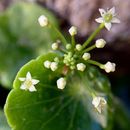Comprehensive Description
provided by North American Flora
Hydrocotyle umbellata L. Sp. PI. 234. 1753
Hydrocotyle umbellulala Michx. Fl. Bor. Am. 1: 161. 1803 .
Hydrocotyle incrassatum Raf. Fl. Ludov. 81. 1817. Not H. incrassatum Ruiz & Pav. 1802.
Hydrocotyle polystachya A. Rich. Ann. Gen. Sci. Phys. 4: 171. 1820.
Hydrocotyle polystachya var. quinqueradiata Thouars; A. Rich. Ann. Gen. Sci. Phys. 4: 171. 1820.
Hydrocotyle umbeUata var. umbellulala DC. Prodr. 4: 60. 1830.
Hydrocotyle petiolaris DC. Prodr. 4: 60. 1830.
Hydrocotyle fiuitans DC. Prodr. 4: 69. 1830.
Hydrocotyle Caffra Meissn. Lond. Jour. Bot. 2: 529. 1843.
Hydrocotyle scaposa Steud. Flora 26: 763. 1843.
Hydrocotyle umbeUata var. microphylla Urban in Mart. Fl. Bras. II 1 : 269. 1879.
Hydrocotyle umbeUata var. scaposa Urban in Mart. Fl. Bras. II 1 : 270. 1879.
Hydrocotyle umbeUata var. intermedia Urban in Mart. Fl. Bras. II 1 : 270. 1879.
Stems slender to somewhat fleshy, floating or creeping; leaves orbicular-peltate, excluding the petioles 5-75 mm. in diameter, crenate or crenately lobed, glabrous; petioles mostly slender, 0.5-40.5 cm. long, glabrous; peduncles usually longer than the leaves, 1.5-35 cm. long, glabrous; umbels simple, many-flowered; pedicels 2-25 mm. long, spreading and reflexed; stylopodium depressed; fruit orbicular to ellipsoid in general outline, 1-2 mm. long, 2-3 mm. broad, the dorsal surface acute, the dorsal and lateral ribs evident, obtuse; strengthening cells absent.
Type locality: "America" (Virginia), Clayton 429.
Distribution: Nova Scotia to Florida, west to Minnesota and Texas; Oregon and California, south to Panama and South America; Bermuda and the West Indies; coastal plains and along streams below 8000 feet. (Curtiss 5676, Ekman H5653.)
- bibliographic citation
- Albert Charles Smith, Mildred Esther Mathias, Lincoln Constance, Harold William Rickett. 1944-1945. UMBELLALES and CORNALES. North American flora. vol 28B. New York Botanical Garden, New York, NY
Hydrocotyle umbellata: Brief Summary
provided by wikipedia EN
Hydrocotyle umbellata is an aquatic plant that thrives in wet, sandy habitat. Its English common name is manyflower marshpennywort or dollarweed. It is native to North America and parts of South America. In Brazil it is known as acariçoba and has applications in herbal medicine with purported anxiolytic, analgesic and anti-inflammatory properties. It can also be found growing as an introduced species and sometimes a noxious weed on other continents. It is an edible weed that can be used in salads or as a pot herb.
- license
- cc-by-sa-3.0
- copyright
- Wikipedia authors and editors

